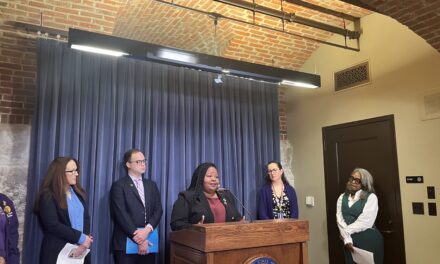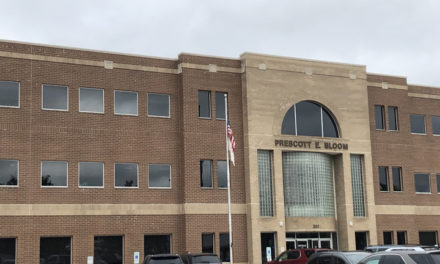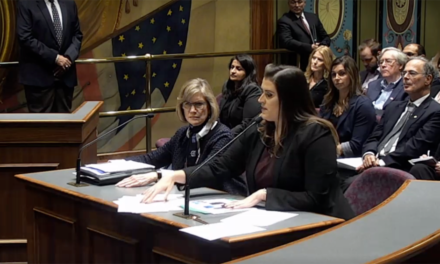
On the record with Suzet McKinney, CEO, Illinois Medical District

Illinois Medical District CEO Suzet McKinney thinks there’s no reason Chicago can’t become the country’s next hub for life sciences.
And she believes the district – home to four hospitals, research labs and more than 40 healthcare-related facilities on Chicago’s west side – is uniquely situated to be at the center of that emergence.
“We’re already home to much of the core infrastructure and institutional capital that can help drive successful innovation districts,” McKinney said in a recent interview with Health News Illinois. “This is the ideal place to really advance and cultivate that for the benefit of our city and our state.”
Read more below.
HNI: Now, the country’s biggest life sciences clusters are on the east and west coasts. Why do you think Chicago can become the “Third Coast” for life sciences?
SM: First of all, I think Chicago is very rich in terms of the resources and assets that we have here in the city related to healthcare as well as technology. There is no secret that Boston on the east coast and San Francisco on the west coast are the two main areas where healthcare, specifically life sciences, and the tech industry collide. But there is really not a whole lot in between, particularly of the size and magnitude of the resources we have right here in Chicago. So I think that because the components of a successful life sciences hub, such as medical institutions, academia, transportation, startups, incubators and diverse patient populations all exist here, there’s absolutely no reason Chicago cannot become that third hub.
HNI: How does Chicago’s life sciences industry compare to other cities?
SM: I would say that life sciences in Chicago and in Illinois are lagging in comparison to other cities, despite what we see as a very healthy industry growth nationwide. Nationally, life sciences currently has 86,000 businesses and employs more than 1.73 million, and those employment numbers continue to grow. In fact, based on our research, we found that employment numbers within the life sciences have grown by 19 percent since 2001. And the number of new businesses have grown at a 40 percent rate since 2001. When you compare Chicago to other cities, and particularly in academic spending on life sciences R&D, we are ranked about ninth, behind other smaller cities like Philadelphia and St. Louis.
HNI: Why does Chicago lag behind these other cities?
SM: I think we’ve just seen many life science companies leave the Chicago area in favor of the coasts because life sciences is an industry that is supported and growing in those areas. I think, and this is just an opinion, perhaps we have not focused as much on innovation clusters for life sciences. And what we know is that innovation clusters thrive when there is collaboration and sharing among the life sciences and tech companies. We see that trend growing everywhere we look. I mean, just look at Philadelphia and St. Louis. So I think because we have not placed as much of an emphasis on the clustering and the collaborations here, we’ve seen the life science companies flee to the coasts.
I would also say if you look at funding trends, just for example, from the National Institutes of Health, funding here in Illinois has lagged significantly behind other cities and other states.
HNI: The district said in a paper earlier this year that there needs to be more focus on bringing together tech and life science industries in Chicago. What role, if any, does the district play in that?
SM: We continue to develop vacant land here in the medical district and we continue to grow the number of partners that are residing here in the medical district. We believe what we are doing is creating – or better yet – we believe we are advancing this very phenomenon of vibrant innovation clusters where there is this extreme collaboration. We believe that when researchers, startups and established industry leaders work in close proximity, and that’s the key for the clustering, there’s an increase in knowledge and idea sharing, which boosts innovation and economic activity. We believe that because we’re already home to much of the core infrastructure and institutional capital that can help drive successful innovation districts that this is the ideal place to really advance and cultivate that for the benefit of our city and our state.
And I will also add that the governor’s office just released his economic development plan, and we were very happy to see that this is a priority in our state’s economic development. So we feel like we are on the right track and our research is proving itself to be valid. But I think the other piece to mention is that you cannot build an innovation district overnight. Successful innovation districts and the infrastructure that they contain takes generations to develop and the Illinois Medical District is the largest medical district in the state of Illinois and the most well established. We’ve been here for 78 years, so we believe we are poised to do exactly what we are setting out to do, which is to cultivate and advance the life sciences here in the state of Illinois.
HNI: What role can health systems and providers play in building up this life sciences cluster?
SM: I think healthcare delivery, access to healthcare and health outcomes, are the center of our work. The role I think health systems and providers can play is to not be afraid to work together, to share data, collaborate with one another in research, but also with the industry in research. We believe that this collaboration, both with other research partners and the industry, can help develop new care models such as digital health platforms and telemedicine and others that all have the goal of closing some of the most staggering health disparities that exist in communities right here in Chicago and communities all across the country. We believe that advanced data collection can improve diagnostic treatment, as well as outcomes. These are all new and emerging methodologies that healthcare systems and providers can embrace as a means of improving health outcomes. Historically, health systems and providers have been averse to sharing their data, but I think this is a time of change and this is an area where data sharing can be more advantageous for all of the partners.
And I’ll say this, what we’re seeing across the country is where healthcare systems and providers are coming together to share data to collaborate with industry partners, that’s attracting more and more private businesses to those innovation clusters and really ramping up new health and medical interventions and products that can be brought to market to improve health outcomes and even improve access to health.
HNI: What are some of the medical innovations occurring at the district?
SM: Well that’s a hard question to answer because health systems, historically, have not been as willing to share data or to share what they’re doing. I think it goes without saying that the University of Illinois at Chicago, specifically its school of pharmacy, is one of the most advanced pharmacy schools in the country and the last time we looked they had the most patents of any other school of pharmacy in the country. So there’s quite a bit of work that’s going on right here on the west side of Chicago.
There are a couple of incubators here at the medical district. There is one incubator that currently has 20 companies that are occupying space here at the IMD. And then the incubator lab facility operates as a commercial lab, and it currently is at 60 percent capacity.
Rush University Medical Center actually has a division within the hospital that assists inventors, authors and other creators of intellectual property at Rush in the process of going through IP disclosure, marketing and licensing. And as I said before, UIC in their west campus has the Center for Innovation that offers classes, laboratories and sponsored projects.
HNI: What more can policymakers do to support innovation districts?
SM: I’d say that, based on what we’ve seen through our work, it’s safe to say that federal, state and local governments have all played a key role in the formation of innovation districts across the country, but with public-private partnerships typically being at the front and center of those roles. So I think that government stakeholders play different roles in different states and different cities. But some of the common functions include providing startup and investment capital, as well as providing the organizing drive in the absence of another coordinating institution, if you will. But I think in every single case that we’ve looked at all the way across the country, government buy-in is critical because it supports bringing participants to the table, fostering the collaborative spirit and sense of mission. Fundamentally, innovation districts are mission-driven efforts to foster new, rejuvenate flagging or even expand successful industry clusters. So I think the convening, the sense of mission, fostering that collaborative spirit and, where possible, the infusion of capital funding, as well as the encouragement of public-private partnerships, are all things that policymakers can do. And they are things we have seen happen in other places that have led to the presence of so many successful innovation districts across the country.
Health News Illinois is a nonpartisan, independent news service covering the Illinois healthcare beat. Sign up for a free trial to the newsletter here.









